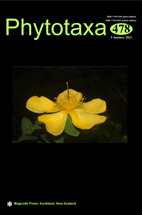Abstract
Gyrocheilos taishanense G.T. Wang, Yu Q. Chen & R.J. Wang (Gesneriaceae) from south China is described and illustrated with photographs. It is morphologically similar to G. microtrichum W.T.Wang, but it is distinguished by its glabrous or sparsely hairy pedicels, zygomorphic calyx with hairs in unequal length, and slightly bilobed adaxial corolla lips. Molecular phylogenetic analysis based on nuclear ITS and plastid trnL-F sequences strongly supported this new species as sister to a clade comprising the previously described Gyrocheilos species (100% posterior probability and bootstrap support). The new species is evaluated here as Least Concern (LC) according to the IUCN Red List Categories and Criteria.

